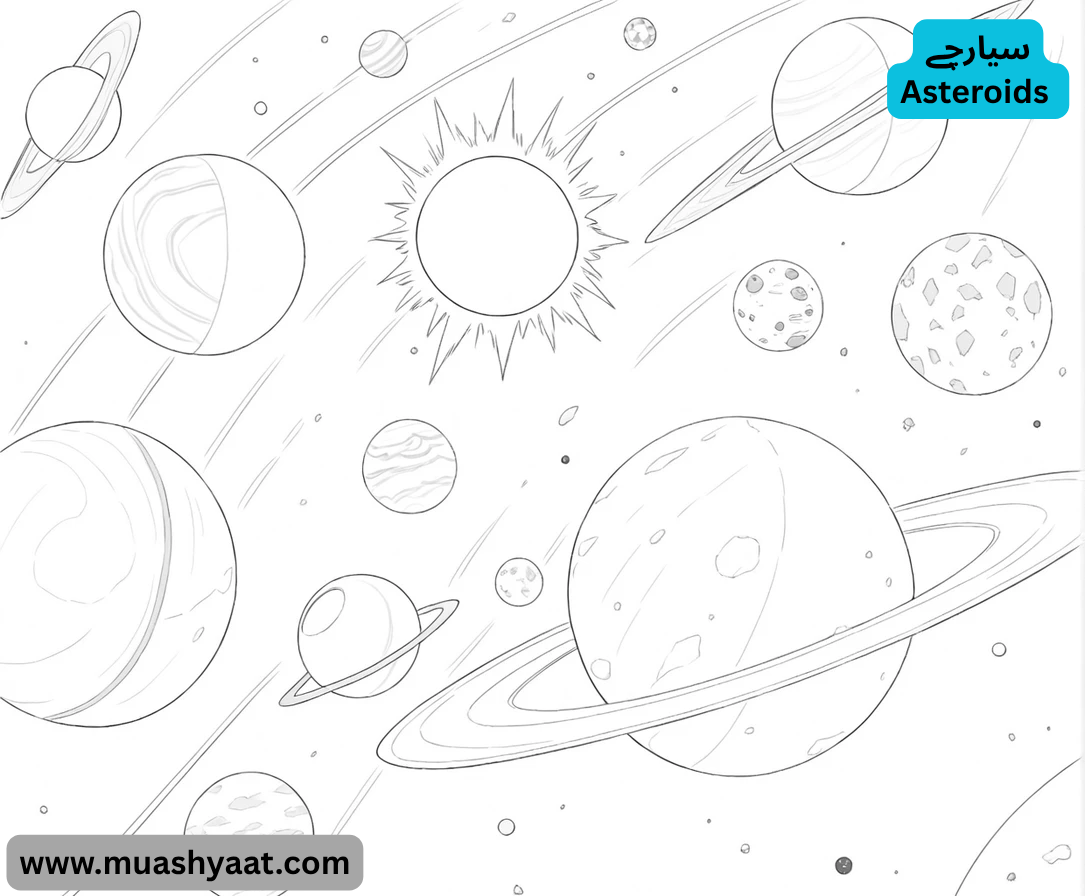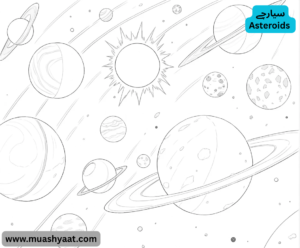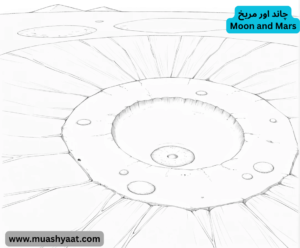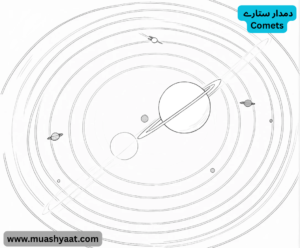سیارچے ⇐نظام شمسی میں شامل دس بڑے سیاروں اور ان کے چاند کے علاوہ ان دس سیاروں کے مادے ہی پر مشتمل بے شمار چھوٹے بڑے ٹکڑے ان سیاروں کے درمیانی حصوں میں رہتے ہوئے سورج کے گرد چکر لگار ہے ہیں ۔ ان کو سیارچے کہتے ہیں۔
Asteroids In addition to the ten majo r planets and their moons in the solar system, there are countless small and large pieces of matter from these ten planets that orbit the sun in the middle of these planets. These are called asteroids.
سیارچوں کی تعداد
ایک اندازے کے مطابق ان سیارچوں کی تعداد پچاس ہزار کے قریب ہے۔ ان کی جسامت ایک چھوٹے سے سیارچے سے لے کر کئی سو کلو میٹر قطر کے سیارچے تک ہے۔ سب سے بڑے سیارچے کا قطر 770 کلو میٹر ہے۔ ابھی تک ان سیارچوں کی موجودگی کے بارے میں کوئی بات وثوق سے نہیں کی جاسکتی۔
Number of satellites
According to one estimate, the number of these satellites is about fifty thousand. Their size ranges from a small asteroid to an asteroid with a diameter of several hundred kilometers. The diameter of the largest asteroid is 770 kilometers. As of now, nothing can be said with certainty about the existence of these satellites.
سائنس دانوں کا خیال
بعض سائنس دانوں کا خیال ہے کہ یہ سیارچے اسی وقت بنے جب کہ یہ سیارے اس کا ئنات کے اندر وجود میں آرہے تھے البتہ یہ سیار چے گردش کے دوران شاید آپس میں ٹکرا کر مزید چھوٹے چھوٹے ٹکروں میں بٹتے رہتے ہیں اور ٹکرانے کے بعد چاروں طرف بکھر جاتے ہیں۔ ان میں سے کچھ زمین، چاند اور دوسرے سیاروں پر بھی گر پڑتے ہیں۔
Scientists’ view
Some scientists believe that these asteroids were formed at the same time as these planets were coming into existence within the universe, however, these asteroids probably collide with each other during their rotation and continue to break into smaller fragments and scatter in all directions after the collision. Some of them also fall on the Earth, the Moon and other planets.
چاند اور مریخ
شاید ایسے ہی ٹکروں کے گرنے سے زمین پر بعض مقامات پر گڑھے موجود ہیں ( مثلا امریکہ کی ریاست اریزونا کا گڑھا ) چاند اور مریخ پربھی اسی قسم کے بڑے بڑے گڑھے بنے ہوئے ہیں۔ اگر چہ پچھلے سو سالوں سے کوئی قابل ذکر گڑھا نہیں پڑا۔ مگر پھر بھی چاند کی سطح پر نئے پیدا ہونے والے چھوٹے گڑھوں کی نشاندہی آج کل بھی کی جاسکتی ہے اور وثوق سے کہا جاسکتا ہے کہ یہ چھوٹے چھوٹے گڑھے ان سیارچوں ہی کے گرنے سے بنے ہیں۔
Moon and Mars
Perhaps due to the fall of such impacts, there are craters in some places on Earth (for example, the crater in the state of Arizona, USA). Similar large craters have been formed on the Moon and Mars. Although there has not been any notable crater for the past hundred years, new small craters on the surface of the Moon can still be identified today and it can be reliably said that these small craters were formed by the fall of these asteroids.
شہاب ثاقب
نظام شمسی میں سیارچوں سے چھوٹے اجسام بھی موجود ہیں جو سورج کے گرد چکر کاٹتے رہتے ہیں۔ ماہر ارضیات انہیں آسمانی تحائف بھی کہتے ہیں۔ کیونکہ ان کی بناوٹ اور ساخت سے سیاروں کی پیدائش کے متعلق اہم معلومات حاصل ہوتی ہیں۔ اس قسم کے اربوں چھوٹے بڑے ٹکڑے فضاء میں موجود ہیں ۔ گردش کے دوران ان میں سے کئی اکثر آپس میں ٹکرا جانے کی وجہ سے یا پھر سیاروں کی کشش کے زیر اثر ان کی سطح پر گرتے رہتے ہیں ۔
Meteorite
There are also bodies smaller than asteroids in the solar system that orbit the Sun. Geologists also call them celestial gifts. Because their composition and structure provide important information about the birth of planets. Billions of such small pieces are present in the atmosphere. During their rotation, many of them often fall to the surface of the planets due to collisions or under the influence of their gravity.
زمین کی فضاء
ہماری زمین کی فضاء میں بھی یہ روزانہ ہزاروں میں داخل ہوتے رہتے ہیں۔ ان میں سے اکثر زمین کی فضاء میں داخل ہوتے ہی رگڑ کی وجہ سے جل کر خاک ہو جاتے ہیں۔ یہ خاک فضاء ہی میں منتشر ہو جاتی ہے۔ آپ نے بھی اکثر رات کے وقت فضاء میں جلتے ہوئے ذرے اور ٹکڑے دیکھے ہوں گے جو بے حد چمکدار روشنی کی لکیر بناتے ہیں۔ اسے عام طور پر ستارہ ٹوٹنا کہتے ہیں۔
Earth’s Atmosphere
Thousands of them enter our Earth’s atmosphere every day. Most of them burn up and turn into dust due to friction as they enter the Earth’s atmosphere. This dust is dispersed in the atmosphere. You must have often seen burning particles and fragments in the atmosphere at night, which create a very bright line of light. This is usually called a starburst.
شہاب ثاقب کی بارش
در حقیقت یہ شہاب ثاقب ہیں ۔ بعض اوقات یہ ایک ہی گھنٹے شہاب ثاقب کی بارش سے تشبیہ دی جاتی ہے۔ میں ہزاروں کی تعداد میں فضاء میں داخل ہوتے ہیں۔ اس کی وجہ سے روشنی کی بے شمار لکیریں جگمگا اٹھتی اسے شہاب ثاقب کی بارش سے تشبیہ دی جاتی ہے۔
Meteor Shower
These are actually meteors. Sometimes they are likened to a meteor shower in a single hour. Thousands of them enter the atmosphere. Due to this, countless streaks of light flash, it is likened to a meteor shower.
دمدار ستارے
نظام شمسی میں سورج کے گرد گردش کرنے والے اجسام میں دمدار ستارے بھی شامل ہیں۔ ان ستاروں کے مدار بے حد بیضوی ہوتے ہیں یہ ستارے صرف اس وقت نظر آتے ہیں جب یہ سورج کے قریب آتے ہیں۔ اپنے مدار پر سورج سے دور جاتے ہوئے ان کی روشنی مدہم ہوتی جاتی ہے اور پھر آسانی سے نظر نہیں آتے۔
Comets
Comets are among the objects orbiting the Sun in the Solar System. The orbits of these stars are extremely elliptical. These stars are only visible when they come close to the Sun. As they move away from the Sun in their orbits, their light dims and they are then not easily visible.
ستارے کا رخ
جیسا کہ نام سے ہی ظاہر ہے کہ اس کا سرا اور ایک لمبی سی پھیلی ہوئی دم ہوتی ہے جوں جوں یہ ستارہ سورج کے قریب آتا جاتا ہے اس کا سرا اور لمبی پھیلی ہوئی دم اور زیادہ پھلنے اور چمکدار ہونے لگتی ہے اگر چہ اس ستارے کا رخ سورج کی طرف ہوتا ہے مگر اس کی دم سورج کی حرارت کے دباؤ کی وجہ سے پرے بھاگتی ہے
Star’s direction
As the name suggests, it has a tip and a long, spreading tail. As the star gets closer to the sun, its tip and long, spreading tail start to expand and become brighter. Although the star is facing the sun, its tail is pushed away by the pressure of the sun’s heat.
ستارے کی دم
تحقیق سے ثابت ہوا ہے کہ اس ستارے کی دم در اصل ستارے ہی کے مادے کے چھوٹے چھوٹے ریزے اور گیس پر مشتمل ہوتی ہے
جو سورج کی حرارت کی وجہ سے اس سے علیحدہ ہوتے ہیں اور پھر سورج کی روشنی ہی سے چمکتے ہیں۔
بعض دمدار ستاروں کا مدار ہماری زمین کے مدار کو چھوتا ہوا گزرتا ہے
جس کی وجہ سے ہماری زمین کبھی کبھار اس ستارے کی دم میں سے گزرتی ہے۔
The tail of a star
- Research has shown that the tail of a star is actually made up of tiny particles of matter and gas from the star
- which are separated from it by the heat of the sun and then shine with the light of the sun.
- The orbit of some comets passes by touching the orbit of our Earth
- due to which our Earth sometimes passes through the tail of this star.
چھوٹے چھوٹے ریزے
اس دوران ہزاروں چھوٹے چھوٹے ریزے شہاب ثاقب کی شکل میں زمین کی فضاء میں داخل ہوتے ہیں۔ ویسے تو ایک سال کے دوران چار پانچ چھوٹے دیدار ستارے نظر آجاتے ہیں۔ مگر زیادہ چمکدار ستارہ پانچ یا دس سال کے وقفے کے بعد ہی نظر آتا ہے۔ ایک مخصوص اور بے حد چمک دارستارہ ہیلے کے نام سے مشہور ہے جو 1910ء میں پہلی مرتبہ نظر آیا تھا۔ اس سال یعنی 1910ء کے دوران یہ ستارہ 26 اپریل سے 12 جون تک نظر آتا رہا۔
Small meteors
During this time, thousands of small meteors enter the Earth’s atmosphere in the form of meteors. In fact, four or five small meteors are seen in a year. But the brightest star is seen only after a gap of five or ten years. A specific and extremely bright star is known as Halley’s, which was first seen in 1910. During that year, i.e. 1910, this star was visible from April 26 to June 12.
روشنی اور دم کی لمبائی
اس عرصے میں 6 مئی کو یہ سورج سے قریب تر تھا۔
اس وقت اس کا سر اور پیچھے پھیلی ہوئی دم بے حد روشن اور لمبی تھی۔
اس کے بعد یہ ستارہ سورج سے پیچھے ہٹتاگیا۔
اس کی روشنی اور دم کی لمبائی میں کمی آتی رہی
حتی کہ 12 جون کے بعد یہ روپوش ہو گیا۔
تحقیقات سے معلوم ہوا ہے کہ اس دمدار ستارے کا مدار بہت بڑا ہے۔ اور یہ 76 سال میں اپنے مدار پر ایک چکر پورا کرتا ہے۔ آخری مرتبہ یہ ستارہ 1986ء میں دوبارہ دیکھا گیا۔
Light and tail length
- During this period, it was closest to the Sun on May 6.
- At that time, its head and the tail that extended behind were extremely bright and long.
- After that, the star moved away from the Sun.
- Its light and tail length continued to decrease
- It even disappeared after June 12.
Research has shown that the orbit of this comet is very large. And it completes one revolution in its orbit in 76 years. The last time this star was seen again was in 1986.
ہم أمید کرتے ہیں آپ کو “سیارچے” کے بارے میں مکمل آگاہی مل گئی ہوگی۔۔۔
MUASHYAAAT.COM 👈🏻 مزید معلومات کیلئے ہمارے اس لنک پر کلک کریں
ہماری ویب سائٹ پر آنے کیلئےشکریہ




